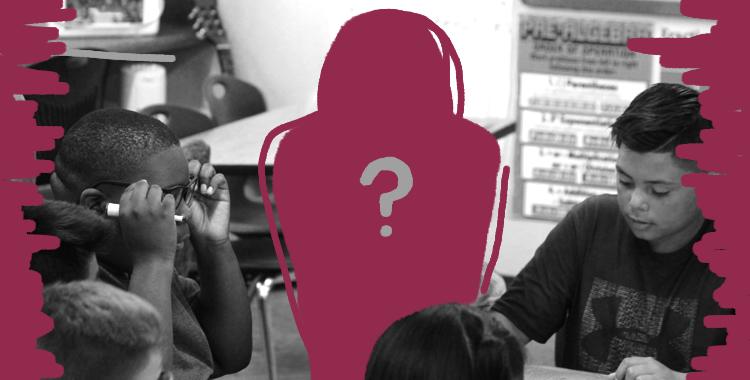Substitutes and (in)equity

In previous posts, I’ve introduced the big argument for the Next Education Workforce, offered some thoughts on the relationship between educator development and personalized learning, and asserted that questions about equity need to live at the heart of our work.
As we have engaged schools and districts in this work, we are seeing how prevalent school staffing practices mismanage human capital in ways that impede equity. One of the groups we look at are substitutes — specifically, the unfairness that is a consequence of having to rely on substitutes to fill vacancies when that one teacher is absent from the one-teacher-one-classroom model.
That unfairness falls disproportionately on schools in minority and low-income communities where absentee rates of teachers average 28% and, in some states, are as high as 50%.
Last August, Chicago’s Public radio station WBEZ looked at how teacher vacancies played out across Chicago public schools by race and ethnicity and found the following: There were yearlong teacher vacancies at 99 majority-black schools, 45 majority Hispanic schools, 8 mixed schools and 0 majority-white schools.
These numbers are as distressing as they are unsurprising. Teacher vacancies and turnover have long been associated with the educational attainment gap. And we all know how principals are forced to fill those vacancies: with substitutes, who are often uncertified, unqualified and asked to do little more than making sure nobody gets hurt at school.
Back in September 2015, the Washington Post published a story headlined “High-poverty schools often staffed by rotating cast of substitutes.” The article notes that “in the troubled schools that serve some of the nation’s neediest children, it is not uncommon for classrooms to churn with substitutes as teachers leave in large numbers each June, or quit midyear, and principals struggle to fill the positions.”
So we come back to the one-teacher-one-classroom model. If you’re a school leader and a teacher falls ill or quits, you’re likely going to a bullpen of substitutes. In the best-case scenario, an experienced substitute who can fill in for a long time, you’re still looking at a considerable time for that substitute to get to know and understand a group of 30 learners. And the best case is rare – and rarer still in low-income and minority-majority school districts.
In contrast, the team-based approach to teaching envisioned in Next Education Workforce models provides a resiliency that the brittleness of the prevalent one-teacher-one-classroom model lacks.
Consider Aesop’s fable about the bundle of sticks: a father summons his quarreling children. He takes one stick and holds it out in front of his chest with two hands and snaps it in half. Then he picks up a bundle of sticks and tries to snap them. They hold.
If one of your team can’t make it to work, you still have most of your team. The day or the week might be different than what it otherwise would have been. But learning need not come to a screeching halt. It will not have to be completely abandoned for the sake of bare-bones classroom management. Every kid will experience some continuity in instruction rather than a complete break. In the best case, in schools and districts that scale Next Education Workforce models, the team would be flexible enough to absorb the absence and maintain instructional quality. Funding currently used for substitutes could be used to build teams in other ways, with more skilled part- or full-time employees who know the learners, hopefully avoiding disruption.
Next Education Workforce models are predicated on the understanding that it is unreasonable (which is a polite way of saying systematically insane) to ask all teachers to be all things to all people. If it’s unreasonable to ask that of full-time certified teachers, how much more unreasonable is it to ask of substitutes? And how much more systematically insane when, in the aggregate, we require less education, less domain knowledge and less clinical experience than we require of full-time certified teachers?
While some districts maintain meaningful requirements for substitute certification and while some substitutes are formerly certified retired teachers, the fact remains that many substitutes are underprepared. If you’re a hiring manager in a district plugging holes in your staff as fast as you can, you don’t have the luxury of demanding competence, let alone excellence. You’re happy to fulfill the minimum state requirements, which in many states, such as Arizona, require the following: a bachelor’s degree and fingerprint clearance. Districts have the discretion to set their own requirements and demand more skills. But, when a district faces an environment of teacher vacancies and attrition, the market incentives pressure them to lower the bar, not raise it.
But Next Education Workforce models account for part-time educators by design. That’s a universe away from substitution, which accounts for adult bodies but not for instructional quality. Role-specialization, as envisioned in Next Education Workforce models, emphasizes preparation. Ultimately, we should have a regimen of credentials tied to specialized knowledge at various levels so that more people can enter the education workforce. When that’s the case, our “substitutes” will be role players, well-prepared and certified to add meaningful value to classroom learning experiences.
So I think there is a good reason to believe that Next Education Workforce Models have the potential to reduce the prevalence of substitution, the leakage of learning time that substitution causes, and therefore the discriminatory effects that current staffing models reliant on substitution have on low-income and majority-minority schools.